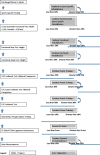ACL Return to Sport Guidelines and Criteria
- PMID: 28702921
- PMCID: PMC5577421
- DOI: 10.1007/s12178-017-9420-9
ACL Return to Sport Guidelines and Criteria
Abstract
Purpose of review: Because of the epidemiological incidence of anterior cruciate ligament (ACL) injuries, the high reinjury rates that occur when returning back to sports, the actual number of patients that return to the same premorbid level of competition, the high incidence of osteoarthritis at 5-10-year follow-ups, and the effects on the long-term health of the knee and the quality of life for the patient, individualizing the return to sports after ACL reconstruction (ACL-R) is critical. However, one of the challenging but unsolved dilemmas is what criteria and clinical decision making should be used to return an athlete back to sports following an ACL-R. This article describes an example of a functional testing algorithm (FTA) as one method for clinical decision making based on quantitative and qualitative testing and assessment utilized to make informed decisions to return an athlete to their sports safely and without compromised performance. The methods were a review of the best current evidence to support a FTA.
Recent findings: In order to evaluate all the complicated domains of the clinical decision making for individualizing the return to sports after ACL-R, numerous assessments need to be performed including the biopsychosocial concepts, impairment testing, strength and power testing, functional testing, and patient-reported outcomes (PROs). The optimum criteria to use for individualizing the return to sports after ACL-R remain elusive. However, since this decision needs to be made on a regular basis with the safety and performance factors of the patient involved, this FTA provides one method of quantitatively and qualitatively making the decisions. Admittedly, there is no predictive validity of this system, but it does provide practical guidelines to facilitate the clinical decision making process for return to sports. The clinical decision to return an athlete back into competition has significant implications ranging from the safety of the athlete, to performance factors and actual litigation issues. By using a multifactorial FTA, such as the one described, provides quantitative and qualitatively criteria to make an informed decision in the best interests of the athlete.
Keywords: ACL injury; ACL reconstruction; Criterion-based progression; Functional testing; Return to sport; Testing algorithm.
Conflict of interest statement
Conflict of Interest
George J. Davies and Matthew Provencher declare that they have no conflict of interest.
Eric McCarty reports consultancy fees from Zimmer and Biomet, Royalties from Elsevier, and institutional and educational support from Arthrex, Smith Nephew, and Depuy Mitey, outside of the submitted work.
Robert Manske reports royalties from Elsevier Science and Human Kinetics, and an honorarium from Rehab Champions, outside of the submitted work.
Human and Animal Rights and Informed Consent
This article does not contain any studies with human or animal subjects performed by any of the authors.
References
-
- Heard BJ, Solbak NM, Achari Y, et al. Changes of early post-traumatic osteoarthritis in an ovine model of simulated ACL reconstruction are associated with transient acute post-injury synovial inflammation and tissue catabolism. Osteoarthr Cartil. 2013;21(12):1942–1949. doi: 10.1016/j.joca.2013.08.019. - DOI - PubMed
Publication types
LinkOut - more resources
Full Text Sources
Other Literature Sources
Medical
Research Materials
Miscellaneous


